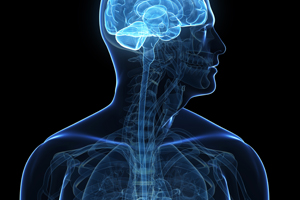








 The parasympathetic nervous system, the sympathetic nervous system, and the enteric nervous system comprise the autonomic nervous system in the body. The autonomic nervous system is continuously active and is responsible for unconscious regulation of our glands and organs. The parasympathetic nervous system takes care of “rest and repair” activities, such as salivation, tears, sexual arousal, urination, digestion and defecation. These activities are complementary to those of the sympathetic nervous system, which activates processes associated with the “fight or flight” response.
The parasympathetic nervous system, the sympathetic nervous system, and the enteric nervous system comprise the autonomic nervous system in the body. The autonomic nervous system is continuously active and is responsible for unconscious regulation of our glands and organs. The parasympathetic nervous system takes care of “rest and repair” activities, such as salivation, tears, sexual arousal, urination, digestion and defecation. These activities are complementary to those of the sympathetic nervous system, which activates processes associated with the “fight or flight” response.
The natural opposition of the sympathetic and parasympathetic nervous systems provides both quick responses when needed, and slower responses for less urgent needs. These systems act something like an accelerator and a brake for our body, and help maintain balance, or “homeostasis”. The parasympathetic system is like a brake and helps you save energy, lower blood pressure, decrease heart rate, and it allows digestion to start. It helps return the body to a state of balance after a period of higher sympathetic nervous system activity. Unlike the sympathetic nervous system, these responses are carried out as needed, rather than all at once.
Chiropractic adjustments have been known to affect the autonomic nervous system by promoting parasympathetic system activity and down regulating the sympathetic nervous system. For example, pain receptors are part of the sympathetic nervous system. A chiropractic adjustment may be able reduce the firing of the pain receptor by decreasing input to the spinal cord, thus reducing the sensation of pain.
The parasympathetic nerves originate in spinal cord and in the medulla, part of the brain. The main parasympathetic nerve is the vagus nerve, which is also known as cranial nerve X. The vagus nerve sends information between the brain stem, hypothalamus, and primary organs and glands.
The main functions of the parasympathetic nerves are to conserve energy, so it promotes passive activities such as dissociation, withdrawal, disengagement, and the immobility response. Physical and emotional withdrawal, as well as the negative emotions of shame, hopelessness, disgust, and despair, is also associated with the parasympathetic system. Interestingly, these functions develop later in life than those of the sympathetic nervous system. This is because the inhibitory responses of the parasympathetic system are not conducive to exploring, which is necessary for young mammals in order to be able to grow and learn effectively.
 The sympathetic nervous system, the parasympathetic nervous system, and the enteric nervous system comprise the autonomic nervous system in the body. It operates through a network of neurons throughout the body, which originate inside the vertebral column and extend down to the third lumbar segment of the spine.
The sympathetic nervous system, the parasympathetic nervous system, and the enteric nervous system comprise the autonomic nervous system in the body. It operates through a network of neurons throughout the body, which originate inside the vertebral column and extend down to the third lumbar segment of the spine.
The autonomic nervous system is continuously active and is responsible for unconscious regulation of our glands and organs. The sympathetic nervous system takes charge of “fight or flight” activities, such as pupil dilation, increased heart rate, increased sweating, and increased blood pressure. These activities are complementary to those of the parasympathetic nervous system, which activates processes associated with the “rest and recover” response, such as such as salivation, tears, sexual arousal, urination, digestion and defecation.
The natural opposition of the sympathetic and parasympathetic nervous systems provides both quick responses when needed, and slower responses for less urgent needs. These systems act something like an accelerator and a brake for our body, and help maintain balance, or “homeostasis”. The sympathetic system is like the accelerator, and its responses are carried out all at once, rather than as needed with the parasympathetic nervous system. It is usually activated in response to stress, or anything your body perceives as threatening. In order to maintain the fight or flight response, your body must shut down much of the “rest and repair” activities needed to heal injury. This is where chiropractic care can be helpful.
Chiropractic adjustments have been known to affect the autonomic nervous system by helping to down-regulate the sympathetic nervous system and promote parasympathetic activity. For example, pain receptors are part of the sympathetic nervous system. A chiropractic adjustment may be able reduce the firing of the pain receptor by decreasing input to the spinal cord, thus reducing the sensation of pain.
In general, you want your body to be in a state of rest in order to heal, repair tissues, and grow new tissues. This resting state is also supportive of the immune system, which is highly sensitive to stress and stress hormones. We are more susceptible to illness when we are stressed, because stress hormones are released as part of the fight or flight response. Those hormones are helpful when we need them to deal with a real crisis, but when they are chronically activated due to personal or physical stress, they lower our defenses against illness and disease.
Your chiropractor will conduct a thorough examination and medical history to determine if there is an imbalance between your sympathetic and parasympathetic systems. This imbalance could be contributing to your health problems and may be restored to balance through chiropractic adjustments and manipulations, as well as additional stress-relief techniques.